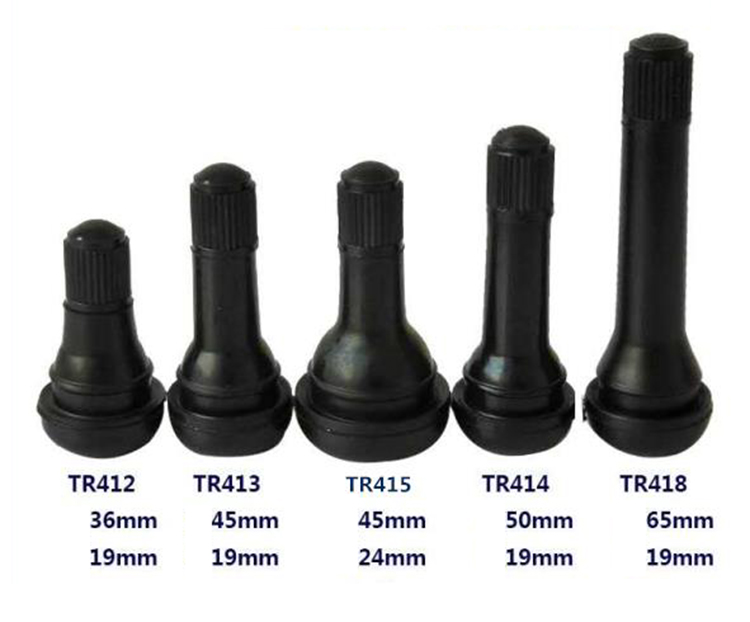Tire Valve Stems: A Complete Guide
The Tire valve stem is a small but critical component of your tire, responsible for maintaining air pressure and allowing inflation/deflation. A damaged or leaking valve stem can lead to slow air loss, poor tire performance, or even a blowout.

Types of Tire Valve Stems
1. Rubber Snap-in Valve Stems
- Material: Rubber with a metal core.
- Installation: Pushed into the rim hole and secured by a rubber gasket.
- Best For: Standard passenger cars, everyday use.
- Pros:
- Inexpensive (2–2–5 each).
- Easy to replace.
- Cons:
- Less durable than metal stems.
- Not suitable for high-pressure tires (e.g., heavy-duty trucks).
2. Metal Clamp-in Valve Stems (High-Pressure)
- Material: Brass or aluminum with a rubber seal.
- Installation: Bolted into the rim with a nut and washer.
- Best For:
- Trucks, SUVs, and performance vehicles.
- TPMS (Tire Pressure Monitoring System) sensors.
- Pros:
- More secure and durable.
- Handles higher PSI (up to 200+ psi for commercial trucks).
- Cons:
- More expensive (10–10–30 each).
- Requires tools for installation.
3. TPMS Valve Stems (Tire Pressure Monitoring System)
- Material: Metal or rubber with an integrated sensor.
- Installation: Similar to clamp-in stems but includes an electronic sensor.
- Best For: Modern cars (2008+ in the U.S., mandatory in many regions).
- Pros:
- Monitors real-time tire pressure.
- Improves safety and fuel efficiency.
- Cons:
- Expensive (30–30–100+ per stem).
- Requires reprogramming when replaced.
4. Tubeless vs. Tube-Type Valve Stems
- Tubeless: Found in most modern cars, seals directly against the rim.
- Tube-Type: Used in older cars, motorcycles, and bicycles (valve is part of the inner tube).
Valve Stem Parts & Anatomy
A standard valve stem consists of:
- Valve Cap (keeps dirt out, prevents leaks).
- Valve Core (controls airflow, removable for pressure checks).
- Valve Body (rubber or metal stem).
- Gasket/Washer (seals against the rim).
When to Replace a Valve Stem?
✔ Visible cracks or dry rot (common in rubber stems).
✔ Leaking air (bubble test with soapy water).
✔ Corroded or bent metal stems.
✔ TPMS warning light (may indicate a faulty sensor stem).
Replacement Cost:
- Rubber stem: 5–5–15 (DIY or at a tire shop).
- Metal/TPMS stem: 20–20–100+ (requires professional service).
- How to Replace a Valve Stem
For Rubber Snap-in Stems:
Deflate the tire completely.
Use a valve stem removal tool to extract the old stem.
Lubricate the new stem and push it into place.
Reinflate the tire and check for leaks.
For Metal Clamp-in Stems:
Remove the tire from the rim (best done by a tire machine).
Unscrew the retaining nut and pull out the old stem.
Insert the new stem, tighten the nut, and remount the tire.
⚠ Note: TPMS stems should be replaced by a professional to avoid sensor damage.
Valve Stem FAQ
1. Can I drive with a broken valve stem?
No! It will cause rapid air loss, leading to a flat tire or blowout.
2. How long do valve stems last?
Rubber stems: 3–5 years (exposure to UV and ozone degrades them).
Metal stems: 5–10+ years (more resistant to wear).
3. Why is my valve stem leaking?
Loose or damaged core (tighten or replace the core).
Cracked rubber (requires full stem replacement).
Faulty TPMS sensor seal (needs professional repair).
4. Are all valve cores the same?
Most use a Schrader valve (same as bike tires), but some high-performance cars use Presta valves.
5. Can I replace just the valve core?
Yes! If the stem is fine but air is leaking from the core, a $1 replacement can fix it. - Best Valve Stem Brands
- Schrader (OEM-quality rubber & TPMS stems).
- Dill (trusted for high-pressure clamp-in stems).
- Alligator (affordable, good for DIY replacements).
- Final Tips
- Always use valve caps (prevents dirt buildup and corrosion).
- Check stems when rotating tires (early detection prevents flats).
- For TPMS, get professional service (sensors are delicate).
- Need help identifying the right valve stem for your car? Share your vehicle model!
Prev:
Are tire caps necessary
Next:
Next:


